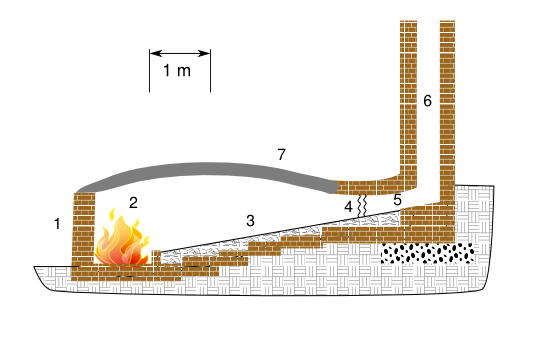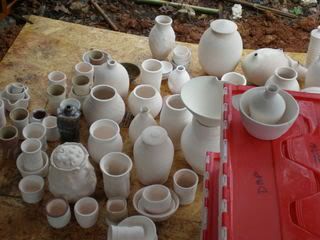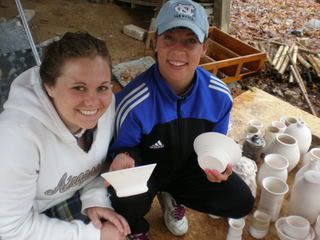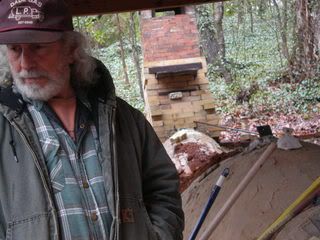The wood-burning kiln is technically known as an anagama kiln. This is the oldest type of ceramic kiln, taking its roots in an ancient Japanese firing practice.
Here is a diagram of an anagram kiln I nabbed from Wikimedia.com-

The kiln has three chambers- the bottom one is for wood-ash, and the top two chambers are for salt and bicarbonate soda. While the old-school anagama kilns were fired exclusively by wood, most modern ones are initially lit with gas or oil, the wood being introduced once the fire was steady. Anagama kilns can normally reach a temperature of around 2100 degrees F, but the hightest temp reached by a wood-burning kiln is 2730 degrees F. Yeah, so it is kinda warm in there. It takes a person throwing more wood in there every 15 minutes to keep the kiln-fire going, which means that someone has to be with the kiln all 24 hours.
A huge effort goes into firing an amagam kiln. So why bother with it? 'Cause art takes work, honey!
In reality, the potters that put their ceramics into the kiln always do so with the knowledge that they have no idea what their pots will come out looking like. The wood-ash settles on the pots, and creates a super-unique texture and color tone that few potters can plan for. In fact, about putting pottery into the anagama kiln, an article in Ceramic Review interviewed a potter, Maureen Mills, who says, "'You don't know what to expect. That's the point of the wood fire. We can do the work and apply the glazes, but we can't control the results."
The article goes on to say "That lack of control adds to the anticipation, which, according to Mills, is 'not really concern so much as excitement about what will come out" (~Ceramic Review~ AND 2008 AND July/August AND 232)
Who knows what these pots will look like after the firing!

Two of my classmates

Artists find this sense of unpredictability intriguing, and the anagama kiln is one of the most enduring firing techniques because of this infatuation.
So, Shorter College is hosting a wood-burning kiln firing this weekend. Tomorrow will be the ceremonial lighting of the kiln ("ceremonial" added in to create a sense of tradition :), and the kiln will continue firing until sometime Sunday night, I believe. My Ceramics class, local potters, and students from West GA and Jack State are all going to be there during one shift or another. They come for the awesome textures the kiln can give their pots, but mostly for the awesome fellowship of the art-community.
Mark, a local potter, by the kiln

Mark and Ian, my professor, by the entrance of the kiln

Due to a massive amount of homework, I will not be able to grace the lighting, but I am scheduled to appear on Sunday from midnight till 6am. Needless to say, I may or may not be at church that day.
Here are a few pics, and there will be more to follow as the weekend progresses.
Hope you enjoy, and I look forward to sharing more of my wood kiln experiences!
No comments:
Post a Comment